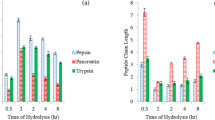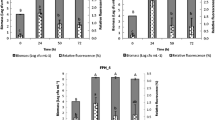Abstract
Protein hydrolysates were prepared from chicken liver using fermentation and enzymatic hydrolysis. The lactic acid bacteria Pediococcus acidilactici NCIM5368 was employed in the fermentation process and a commercial protease (Alcalase® 2.5) was used in enzymatic hydrolysis. Chicken liver hydrolysates prepared by fermentation (FCLH) and enzymatic hydrolysis (ECLH) revealed appreciable amounts of protein [55.85 and 61.34 %; on dry weight basis, respectively]. Fermentation and enzymatic hydrolysis resulted in 14.3 and 26.12 % of degree of hydrolysis. Total antioxidant activity, reducing power, scavenging of superoxide, 2- diphenyl-1-picrylhydrazyl (DPPH) and 2, 2-azino-bis-3-ethyl-benzthiazoline-6-sulphonic acid (ABTS) radicals were determined for both FCLH & ECLH. FCLH & ECLH showed total antioxidant activity of 0.99 and 1.13 μg AAE mg−1 proteins, respectively; while, they scavenged 96.14 and 92.76 % of DPPH radicals respectively. FCLH showed higher ABTS radical scavenging activity (32.16 %) than ECLH (19.29 %). Superoxide anion scavenging activity of FCLH & ECLH were found to be 95.02 & 88.94 %, respectively. Residues obtained after both treatments also exhibited antioxidant activities. FCLH reported highest antagonistic activity against Listeria monocytogenes (30 mm); while, ECLH showed antibacterial activity only against Micrococcus luteus (12 mm). Both hydrolysates have the potential to be a protein rich ingredient for use in formulated foods and possible help in reduction of oxidative stress.



Similar content being viewed by others
References
Abdul L, Mrghni A, Michio M (2010) A review of meat protein hydrolysates and hypertension. Meat Sci 86:110–118
Adje EY, Balti R, Kouach M, Dhulster P, Guillochon D, Nedjar-Arroume N (2011) Obtaining antimicrobial peptides by controlled peptic hydrolysis of bovine hemoglobin. Int J Biol Macromol 49:143–153
AOAC (2000) Official Methods of Analysis, 16th edn. Association of Official Analytical Chemists, Washington DC
Bhaskar N, Modi VK, Govindaraju K, Radha C, Lalitha RG (2007a) Utilization of meat industry by products: protein hydrolysate fromsheep visceral mass. Bioresour Technol 98:388–394
Bhaskar N, Thomas B, Radha C, Lalitha RG (2007b) Optimization of enzymatic hydrolysis of visceral waste proteins of Catla (Catla catla) for preparing protein hydrolysate using a commercial protease. Bioresour Technol 99:335–343
Bligh EG, Dyer WJ (1959) A rapid method of total lipid extraction and purification. Can J Biochem Phys 37:911–917
Bowes VA, Julian RJ (1988) Organ weights of normal broiler chickens and those dying of sudden death syndrome. Can Vet J 29:153–156
Chandini S, Ganesan P, Bhaskar N (2008) In vitro antioxidant activities of three selected brown seaweeds of India. Food Chem 107:707–713
FAO (2012) Statistical Yearbook. Food and Agriculture Organization of the United Nations, Rome, pp 198–200
Gbogouri GA, Linder M, Fanni J, Parmentier M (2004) Influence of hydrolysis degree on the functional properties of salmon byproduct hydrolysates. J Food Sci 69:615–622
Geis AJ, Singh R, Teuber MJ (1983) Potential of lactic streptococci to produce bactericin. Appl Environ Microbiol 45:205–211
Heo SJ, Park EJ, Lee KW, Jeon YJ (2005) Antioxidant activities of enzymatic extracts from brown seaweeds. Bioresour Technol 96:1613–1623
Huang D, Ou B, Prior RL (2005) The chemistry behind antioxidant capacity assays. J Agric Food Chem 53:1841–1856
Ito N, Hiroze M, Fukushima G, Tauda H, Shira T, Tatematsu M (1986) Studies on antioxidant; their carcinogenic and modifying effects on chemical carcinogensis. Food Chem Toxicol 24:1071–1081
Jamdar SN, Harikumar P (2005) Autolytic degradation of chicken intestinal proteins. Biores Technol 96:1276–1284
Jini R, Swapna HC, Amit KR, Vrinda R, Prakash MH, Sachindra NM, Bhaskar N (2011) Isolation and characterization of potential lactic acid bacteria (LAB) from freshwater fish processing wastes for application in fermentative utilisation of fish processing waste. Braz J Microbiol 42:1516–1525
Joseph TR, Reynolds PR, Declan B, Gerald FF, Catherine S (2011) Bioactive peptides from muscle sources: meat and fish. Nutrhu 3:765–791
Jung WJ, Kuk JH, Kim KY, Park RD (2005) Demineralization of red crab shell waste by lactic acid fermentation. Microb Biotechnol 67:851–854
Kim YN (2011) Vitamins. In: Leo MLN, Fidel T (eds) Handbook of analysis of edible animal by-products. CRC Press Boca Raton, FL, pp 161–182
Klompong V, Benjakul S, Kantachote D, Shahidi F (2007) Antioxidative activity and functional properties of protein hydrolysate of yellow stripe trevally (Selaroides leptolepis) as influenced by the degree of hydrolysis and enzyme type. Food Chem 102:1317–1327
Kristinsson HG, Rasco BA (2000) Biochemical and functional properties of Atlantic salmon (Salmo salar) muscle proteins hydrolyzed with various alkaline proteases. J Agric Food Chem 48:657–66
Lambert RJW, Skandamis PN, Coote PJ, Nychas GJE (2001) A study of the minimum inhibitory concentration and mode of action of oregano essential oil, thymol and carvacrol. J Appl Microbiol 91:453–462
Liaset B, Lied E, Espe M (2000) Enzymatic hydrolysis of by-products from the fish filleting industry; chemical characterization and nutritional evaluation. J Sci Food Agric 80:581–589
Metna (2013) Application of Lactic Acid Bacteria fermentation for utilizing poultry Giblets: optimization of fermentation conditions. India: CSIR- central food technological research institute; M.tech. thesis. p. 44–48
Mullaly MM, O’Callaghan DM, Fitzgerald RJ, Donnelly WJ, Dalton JP (1995) Zymogen activation in pancreatic endoproteolytic preparations and influence on some whey protein characteristics. J Food Sci 60:227–233
Nalinanon S, Benjakul S, Kishimura H, Shahidi F (2011) Functionalities and antioxidant properties of protein hydrolysates from the muscle of ornate threadfin bream treated with pepsin from skipjack tuna. Food Chem 124:1354–1362
Nana TH, John HM (1994) Quality of fish protein hydrolysates from herring (Clupea harengus). J Food Sci 59:76–79
Onuh JO, Girgih AT, Aluko RE, Aliani M (2014) In vitro antioxidant properties of chicken skin enzymatic protein hydrolysates and membrane fractions. Food Chem 150:366–373
Pihlanto A, Korhonen H (2003) Bioactive peptides and proteins. Adv Food Sci Nutrition Res 47:175–276
Radha C, Kumar PR, Prakash V (2007) Preparation and characterization of a protein hydrolysate from an oilseed flour mixture. Food Chem 106:1166–1174
Rustad T (2003) Utilization of marine by-products. Electr J Environ Agric Food Chem 2:458–463
Sachindra NM, Bhaskar N (2008) In-vitro antioxidant activity of liquor from fermented shrimp biowaste. Bioresour Technol 99:9013–9016
Shahidi F, Han XQ, Synowiecki J (1995) Production and characteristics of protein hydrolysates from capelin (Mallotus villosus). Food Chem 53:285–293
Sun Y, Daodong P, Yuxing G, Li J (2012) Purification of chicken breast protein hydrolysate and analysis of its antioxidant activity. Food Chem Toxicol 50:3397–3404
Wu HC, Chen HM, Shiau CY (2003) Free amino acids and peptides as related to antioxidant properties in protein hydrolysates of mackerel (Scomber austriasicus). Food Res Int 36:949–957
Xie ZJ, Huang JR, Xu XM, Jin ZY (2008) Antioxidant activity of peptides isolated from alfalfa leaf protein hydrolysate. Food Chem 111:370–376
Zhu KX, Zhou HM, Qian HF (2006) Antioxidant and free radical-scavenging activities of wheat germ protein hydrolysates (WGPH) prepared with alcalase. Process Biochem 41:1296–1302
Acknowledgments
NB thanks Ministry of Food Processing Industries (MoFPI), Govt. of India, New Delhi for partial funding of this work through Science & Engineering Research Board (SERB) (Grant No. SERB/MOFPI/0014/2012 dtd October 8, 2012). Authors thank Prof. Ram Rajasekharn, Director, CSIR-CFTRI, Mysore for the permission to publish the work.
Author information
Authors and Affiliations
Corresponding author
Rights and permissions
About this article
Cite this article
Chakka, A.K., Elias, M., Jini, R. et al. In-vitro antioxidant and antibacterial properties of fermentatively and enzymatically prepared chicken liver protein hydrolysates. J Food Sci Technol 52, 8059–8067 (2015). https://doi.org/10.1007/s13197-015-1920-2
Revised:
Accepted:
Published:
Issue Date:
DOI: https://doi.org/10.1007/s13197-015-1920-2




